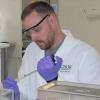GENERAL INFORMATION (C60):
http://www.siliconin...?msgid=19972320
At first they were considered laboratory-created freaks. Then some of them turned up in outer space. Now they're being sent to *ORNL from the frozen reaches of northern Russia. What's going on here?
*ORNL's Bob Hettich was on the case. He analyzed. He checked. He double checked. His conclusion?
"Buckyballs. Definitely buckyballs."
These enigmatic clusters of carbon atoms have been puzzling scientists since 1985 when they were discovered in a research laboratory among the by-products of laser-vaporized graphite. Their hollow spherical structure, reminiscent of the geodesic domes of eccentric architect Buckminster Fuller, earned them the names "buckyballs" and "fullerenes."
*ORNL = Oak Ridge National Laboratory is an American multiprogram science and technology national laboratory managed for the United States Department of Energy (DOE) by UT-Battelle. ORNL is the largest science and energy national laboratory in the Department of Energy system by surface and by annual budget. WIKIPEDIA https://en.wikipedia...onal_Laboratory
...When Buseck and Tsipursky told Hettich (ORNL) that the rock had come from Russia and not a meteorite, he was somewhat surprised. "In the laboratory," says Hettich, "fullerenes are created in an atmosphere of inert gases, like helium, because common diatomic gases, like nitrogen and oxygen inhibit fullerene growth. This is why fullerenes are not found in ordinary soot, like that in household fireplaces. It seemed more likely to find naturally occurring fullerenes in meteorites, where interaction with these gases would be less of a problem."
...The shungite fullerenes are notable not only for their earthly origin, but also because they may have been formed as solids--most laboratory-created fullerenes are grown in the gas phase. "This is the first example of solid-phase fullerene growth," says Hettich, "It has raised a lot of questions about how the rock was formed, how old it is, and how its composition may have changed over time. Because the shungite sample may be volcanic in origin, you can imagine conditions, like those in a volcano, that would be hot enough to form fullerenes and, at the same time, have little or no oxygen or nitrogen present. But right now, no one is sure exactly how these fullerenes were produced."
...To dispel any lingering doubt, Hettich repeated the analysis without a laser, this time using a 400°C stainless steel probe to vaporize the sample and introduce it into the mass spectrometer for ionization. This technique, known as thermal desorption, cannot create fullerenes in fullerene-free graphite material, yet it yielded identical results, confirming the presence of the two types of buckyballs in the sample.
"This kind of discovery raises more questions than it answers," says Hettich, "but that's not necessarily a bad thing."--Jim Pearce
===========================
http://www.derivativ...in-pillow-lava/
Basalt and andesite are the two most common igneous rocks of volcanic and magmatic origin. When a submarine volcano erupts underwater or flows into the sea, it forms basalt and andesite pillow lava.
In Mitov, Czech Republic, "solid bitumin," i.e. hydrocarbons, have been directly observed in pillow lava. This can leave no doubt, save in the mind (or lack thereof) of the most dogmatic biogenic fundamentalist, that hydrocarbons have a volcanic origin. However a biogenic origin is assumed without any evidence whatsoever based upon prejudice, ignorance, and a lack of education. Evidence for fullerenes in solid bitumen from pillow lavas of Proterozoic age from Mítov.
Andesitic pillow lavas containing biogenic, solid bitumen (SB) are a constituent of a Neoproterozoic volcanosedimentary sequence (Teplá-Barrandian unit, Bohemian Massif) in the Mítov area of the Czech Republic.
How can molten igneous Proterozoic pillow lava contain biogenic hydrocarbons? What evidence is there that the bitumin is biogenic? They just ASSUME it's biogenic because it's a hydrocarbon. Wouldn't the lava melt the bitumin if it were biogenic?
Fullerenes (C60) were observed in the "bitumin." Fullerenes have also been observed in Shungite which is elemental igneous carbon.
================================
http://www.thunderbo...917a5&start=765
It should be obvious that the geological source of helium for fullerene generation is in the mantle.
More recently, C60 and C70 have also been found in a sample of glassy rock from the mountains of Colorado. Known as a fulgurite, this type of rock structure is formed when lightning strikes the ground.
Maybe life started when lightning struck a mud puddle after all although this has yet to be repeated in laboratory experiments.
Busek, Tsipursky, and Hettich speculated in a 1992 paper that lightning strikes could provide conditions that are favorable for the formation of buckyballs.
========================
Secrets of "Marcial Waters"
Since the times of Peter I the "Marcial Waters" resort existed in Karelia ( NorthWest Russia). Many years no one could definitively explain the therapeutic properties of this resort. It was assumed that the high content of iron is the cause of health effects. However, there are many sources of iron on earth, and, as a rule, no therapeutic effect.
In 1992, the fullerenes were first discovered on the ground, in the Karelian shungite stone. After that, suspicions arose that the fullerenes are the reason for the healthy effects of the Marcial Waters. However, until now scientists could not determine how this therapeutic effect occurs.
Although the amazing properties shungite are proved by a number of study and practical application. So, for example, during preparation of water from shungite, water is being purified from excess of free radicals. It is known that an excess of free radicals in our bodies is the cause of many diseases. The shungite or fullerene acts in such a way that it defines this excess of free radicals and neutralizes it, thereby purifying the water.
Andrievsky Grigoriy Vladimirovich, Ph.D. in Bioorganic Chemistry, and Klochkov Vladimir Kirillovich, Ph.D. in Physical Chemistry claim that the Martian Water, passing the shungite deposits, is being enriched by fullerenes. Fullerene is not transferred itself in the water, so the water made from shungite cannot hold long the fullerene properties without shungite.
It should be also noted that despite the claims of many scientists about the insolubility and toxicity fullerenes, the team of Andrievsky and Klochkov has developed, however, the method of dissolution of fullerenes in water and proved that such a solution is not toxic. Thus, an aqueous solution of hydrated fullerenes contains the fullerene molecules and holds the fullerene properties for a long time.
SOURCES: http://www.shungite-...en/sources.html





























































